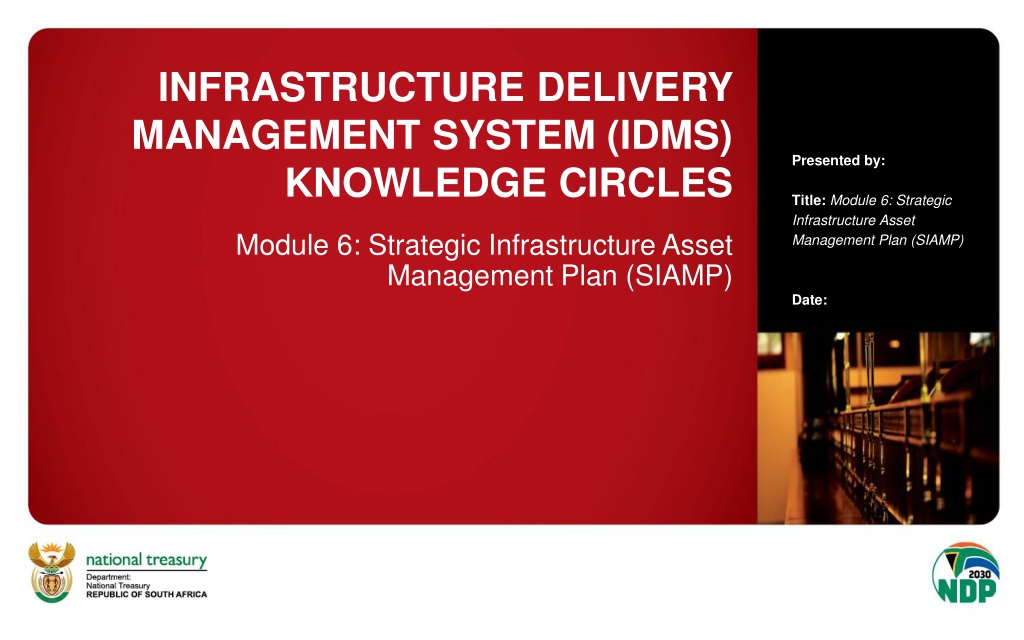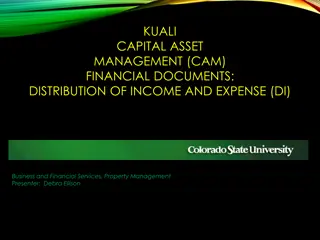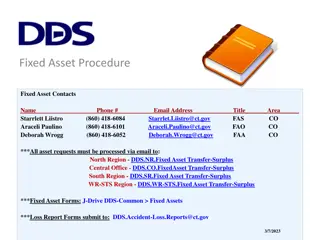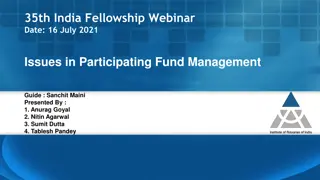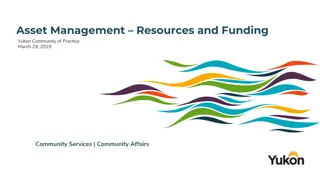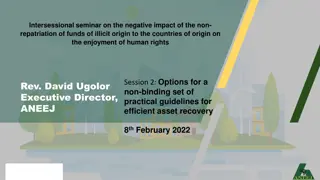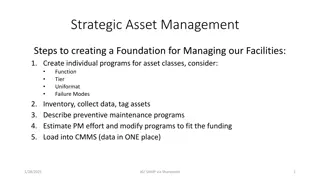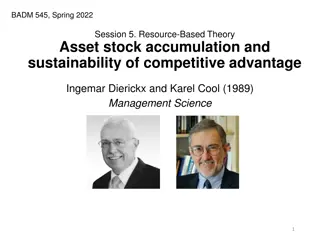Strategic Infrastructure Asset Management Plan (SIAMP) Overview
Strategic Infrastructure Asset Management Plan (SIAMP) Module 6 focuses on portfolio management principles for effective infrastructure asset management. Portfolio managers are guided on planning, managing work portfolios, and collaborating with other delivery management modules. The SIAMP outlines long-term strategies for sustainable infrastructure asset management to deliver optimal service levels while minimizing costs and risks.
- Infrastructure Management
- Asset Management
- Portfolio Management
- Strategic Planning
- Delivery Management
Download Presentation

Please find below an Image/Link to download the presentation.
The content on the website is provided AS IS for your information and personal use only. It may not be sold, licensed, or shared on other websites without obtaining consent from the author. Download presentation by click this link. If you encounter any issues during the download, it is possible that the publisher has removed the file from their server.
E N D
Presentation Transcript
INFRASTRUCTURE DELIVERY MANAGEMENT SYSTEM (IDMS) KNOWLEDGE CIRCLES Presented by: Title: Module 6: Strategic Infrastructure Asset Management Plan (SIAMP) Module 6: Strategic Infrastructure Asset Management Plan (SIAMP) Date:
INFRASTRUCTURE DELIVERY MANAGEMENT SYSTEM (IDMS) KNOWLEDGE CIRCLES Module 6: Strategic Infrastructure Asset Management Plan (SIAMP) PRESENTED BY: DATE:
MODULE 6 Portfolio Management (Version 5.0) 3
Purpose of Module 6: Portfolio Management The purpose of Module 6 is to provide portfolio managers with guidance to enable them to apply portfolio management principles, together with the relevant subject matter material pertaining to infrastructure delivery management, to plan and manage the portfolio of work. It is important to note that the application of Portfolio management on its own is not sufficient to plan and implement the work required to sustain the performance of infrastructure assets needed for public service delivery. It is reliant on workinginsynergy with the other three delivery management modules of Programme Management, Operations and Maintenance and Project Management. 4
Purpose of Module 6: Portfolio Management MODULE 6 Portfolio Management Process MODULE 7 Programme Management Process MODULE 8 Operations & Maintenance Management Process MODULE 9 Project Management Process & Project Lifecycle 5
IAMP Table of Contents 1 Key Terminology 2 Executive Summary 3 Introduction 4 Legislative/Statutory Compliance Requirements 5 Organ of State s Service Delivery Mandate 6 Required Assets to Fulfil the Service Delivery Mandate 7 Updated Infrastructure Asset Register 8 Infrastructure Assets Ownership Strategies 9 Infrastructure Asset Management Strategies 10 Annexures 6
1. Key Terminology SIAMP: The SIAMP is intended to describe the organ of state's long-term approach to managing its infrastructure assets, that will enable the IA portfolio to provide the desired levels of service in a sustainable way, while managing risk, at the lowest lifecycle cost. Asset: An item, thing or entity that has potential or actual value to an organisation. (Such as plant, machinery, buildings, etc.) Asset Management: The systematic and coordinated activities and practices of an organisation, to deliver on its objectives optimally and sustainably, through the cost-effective lifecycle management of assets. Asset Life Cycle: Asset Life Cycle involves the Planning, Acquisition, Utilisation and Disposal of assets. 7
2. Executive Summary The executive summary: Should emphasise the key issues contained in the body of the plan and provide readers with a concise overview of the entire SIAMP. Is not the same as an introduction, as it summarises the entire report. The introduction introduces the plan content and structure for the reader. Should only be written after the entire Plan is completed. This allows for the summary to be both comprehensive and well structured. Note: the investigation and details of the review report must be complete and validated, before the executive summary can be written 8
3. Introduction 3.1 Purpose of the SIAMP The purpose of the SIAMP is to: Outline how the Organ of State s strategic objectives will be translated into infrastructure plans. Outline Infrastructure Asset Life Cycle Management strategies. Provide details of how existing assets will be utilised. Detail the Organ of State s infrastructure assets investment optional analysis and funding strategies. To demonstrate an Organ of State s Asset Life-Cycle Planning and record an in-depth forecast of future infrastructure asset requirements (Demand Management), whilst monitoring existing infrastructure recorded in the Updated Asset Register. Detail the Organ of State s long-term Infrastructure Strategic Planning. Outline how IAM Policy objectives are to be delivered sustainably. 9
3. Introduction Provide the illustration of the Infrastructure Asset Strategy Framework. Figure 1: Infrastructure Asset Strategy Framework 10
3. Introduction 3.2 SIAMP in Context The SIAMP is a deliverable of Strategic Planning Sub-Phase located under the Portfolio Management Processes. The SIAMP outlines how an Organ of State s Strategic Plans will be translated into future infrastructure plans. The SIAMP outlines Life-Cycle Strategic Infrastructure Asset Planning, through efficient management of existing assets and forecasting for the future acquisition of new assets (Demand Management). In the IDM Process Diagram, the SIAMP is located under the Strategic Planning Sub-Phase of the Portfolio Management Processes. The following are the key activities of the Strategic Sub-Phase that culminate in the development and approval of the SIAMP. Review Infrastructure Asset Management (IAM) Objectives. Review IAM Strategies. Analyse the IA Portfolio. Note: The period of validity of the SIAMP is yet to be agreed. It should be reviewed every 3-years and after each election, as the elected political members, or coalitions, are likely to review the strategy, or at least the priorities 11
2. Introduction 3.2 SIAMP in Context Insert the IDM Process Diagram to show the position of the SIAMP within the four Infrastructure Delivery Management (IDM) processes, in the context of the informative guide provided above. Figure 2: Strategic Planning Sub Phase in the IDM Process Diagram 12
2. Introduction 3.2 SIAMP in Context Insert the IDM Portfolio Management Process and Control Points to show the position of the SIAMP within the portfolio management process in the context of the informative guide provided above. Figure 3: Strategic Planning Sub Phase in the Portfolio Management Process 13
3. Introduction 3.3 How the SIAMP relates to the institution's asset management objectives The SIAMP enables the Organ of State to develop strategic infrastructure plans that correlate with the long-term service delivery objectives. The Strategic Planning process steps that result in the development of the SIAMP deliverable are the: Review of Infrastructure Asset Management Objectives, Review of Infrastructure Asset Management Strategies and the Analysis of the Infrastructure Asset Portfolio that is detailed in the Updated Infrastructure Asset Register, 14
4. Legislative/Statutory Compliance Requirements Provide details of the Legislative and Statutory Compliance Requirements, including: The Constitutional Requirements. Government Policy and Legislation. Organ of State Infrastructure Asset Management Policy. 15
5. Organ of States Service Delivery Mandate Provide details of the Organ of State s service delivery objectives and refer to the following: National Government priority programmes. National Development Plan 2035. Provincial Government priority programmes. District Development Plan. Local Government priority programmes. 16
6. Required Infrastructure Assets to Fulfil Service Delivery Mandate Outline the nature of infrastructure assets required to fulfil the Organ of State s service delivery objectives i.e., roads, school buildings, office buildings etc. 17
7. Updated Infrastructure Asset Register An Updated Infrastructure Asset Register is central to an Organ of State s Infrastructure Assets Strategic Planning process. An Updated Infrastructure Asset Register is a critical input to the Strategic Infrastructure Asset Management Plan (SIAMP) and the Infrastructure Asset Management Plan (IAMP). An Updated Infrastructure Asset Register provides a record of the all assets available to an Organ of State, their condition, utilisation and functional performance. Outline the Organ of State's strategies directed at ensuring that an Updated Infrastructure Asset Register is in place, compliant and signed off. 18
8. Infrastructure Asset Ownership Strategies 8.1 Organ of State Ownership Discuss the Organ of State s infrastructure ownership strategies. 8.2 Leasing of Assets Discuss the Organ of State s infrastructure assets lease-in strategies. Could refer to centralised/decentralised infrastructure assets leasing. 19
9. Infrastructure Asset Management Strategies Outline the Organ of State s Infrastructure Asset Management Strategies. Refer to the following as highlighted in the sub-sections: Infrastructure Assets Demand Management Strategies. Infrastructure Asset Life Cycle. Infrastructure Assets Financial Management Strategies. Figure 4 illustrates the Asset management Framework that informs the development of infrastructure asset management strategies. 20
9. Infrastructure Asset Management Strategies Figure 4 illustrates the Asset management Framework that informs the development of infrastructure asset management strategies. Figure 4: Asset Management Framework (UN, 2021) 21
9. Infrastructure Asset Management Strategies 9.1 Infrastructure Assets Demand Management Strategies 9.1.1 Organisational Growth Strategy Briefly outline the Organ of State s growth strategy and how that could impact on the demand for infrastructure assets. 9.1.2 Projected Future Asset Demand Outline the Organ of State s projected future demand for infrastructure assets. Outline strategies in place to cater for the projected increased demand, or strategies in place to relinquish infrastructure assets as a result of decreased future demand/demographic changes. 9.1.3 Condition of existing Asset base Outline strategies in place to conduct periodic condition assessments. Outline strategies in place for the implementation of condition assessments outcomes. Outline the use of conditions assessments in maintenance management. 22
9. Infrastructure Asset Management Strategies 9.1.4 Adaptability Outline strategies in place to ensure provision of adaptable infrastructure assets with capabilities of offering multiple services. Adaptability could refer to infrastructure assets that can render multiple services, or infrastructure assets that could be reconfigured at minimum costs or replaced with a mobile unit. 9.1.5 Reliability Outline strategies in place to determine and ensure prolonged reliability of infrastructure assets. Reliability refers to an infrastructure asset s ability to render services with minimum disruptions or breakdowns. 9.1.6 Compliance Outline the Organ of State s strategies directed towards ensuring that current and new infrastructure assets are compliant, and effectively respond to the service delivery objectives. 9.1.7 Sustainability Detail the Organ of State s sustainability strategies with regards to the current and future demand management of infrastructure assets. 23
9. Infrastructure Asset Management Strategies 9.2 Infrastructure Life Cycle Asset Life Cycle: Asset Life Cycle involves the Planning, Acquisition, Utilisation and Disposal of an Asset (UN, 2021). Provide details in the sub-sections below of an Organ of State s Infrastructure Life Cycle Management Strategies, with reference the following Life-Cycle Management (LCM) Strategies: An Operations LCM strategy which defines the use of existing infrastructure assets, which may include matters such as access, security, accountability and monitoring performance and condition assessment; A Maintenance and Repairs LCM Strategy which defines what existing infrastructure assets are to be maintained, the level of maintenance and the delivery of maintenance and repair services; An Upgrades and Additions LCM Strategy which defines what existing infrastructure assets are to be upgraded, or have additions made to them; A Renewals LCM Strategy which defines the renewals profile for infrastructure assets (this is called Rehabilitation and Refurbishment in SCOA); A New Infrastructure Assets LCM Strategy which defines the new infrastructure assets to be acquired in the planning period. 24
9. Infrastructure Asset Management Strategies The LCM Strategies provide guidance for the revision of LCM Plans for individual facilities, IA networks, or individual infrastructure assets. Provide details in the sub-sections below for the Organ of State s Infrastructure Life Cycle Management Strategies. 9.2.1 Infrastructure Asset Planning Strategies Infrastructure Asset Planning is critical for an Organ of State as it enables the Organ of State to have the right infrastructure asset available to meet its service delivery objectives. Furthermore, infrastructure asset planning enables an Organ of State to plan for the operations and maintenance of the infrastructure assets. Describe in detail the Organ of State s infrastructure asset planning strategies, mechanisms, and tools. 25
9. Infrastructure Asset Management Strategies 9.2.2 Infrastructure Acquisition Strategies Acquisition involves the acquiring of infrastructure assets to meet the organ of states service delivery objectives. Careful planning, cost benefit and optional analysis is required prior to this process. Outline the Organ of State s infrastructure assets acquisition strategies. Could refer to the following: Infrastructure Procurement Strategies. Contracting strategies. Market conditions (inflation, material and labour availability). Risk (corruption during procurement, inadequate or wrong specifications, project disruptions etc.) 26
9. Infrastructure Asset Management Strategies 9.2.3 Infrastructure Utilisation Strategies Detail the Organ of State s Infrastructure Asset utilisation strategies. This covers existing and future individual assets, whereas 8.1.4 covers the existing asset base. 9.2.3.1 Infrastructure Assets Optimal Utilisation Strategies Detail the Organ of State s infrastructure optimal utilisation strategies: Ensuring that infrastructure assets are not over utilised. Ensuring that infrastructure assets are not under utilised. 9.2.3.2 Infrastructure Assets Operations Strategies Detail the Infrastructure Operation Strategies and refer to the following: Operations Budgeting. Operations Personnel. Outsourcing of Operations Activities/Framework Contracts 27
9. Infrastructure Asset Management Strategies 9.2.3.3 Infrastructure Assets Maintenance Strategies Detail the Infrastructure Assets Maintenance Strategies and refer to the following: The strategy to improve the ratio between preventative, corrective, and reactive maintenance (What is done to reduce reactive and corrective maintenance, and increase preventive maintenance). Maintenance Budgeting. Maintenance Personnel. Outsourcing of Maintenance Activities/Framework Contracts. 9.2.4 Infrastructure Asset Disposal Strategies The Organ of State must relinquish surplus assets, and dispose assets that are no longer fit for purpose. These requires careful planning and budgeting. Outline strategies in place for the disposal of infrastructure assets, with reference to the following: Consultation with the custodian and interested Organs of State. Asset valuation to ensure value for money in the instances of sale. Protection of heritage infrastructure assets. Environmental protection. Other legal requirements that are attached to the disposal of an asset. 28
9. Infrastructure Asset Management Strategies 9.3 Infrastructure Financial Management Strategies In a constrained fiscus, the Organs of State must plan and prioritise infrastructure required to meet their service delivery objectives. Cost benefit analyses must be undertaken to ascertain feasibility and viability of infrastructure assets prior to acquisition. Outline the Organ of State s strategies. Address the following with regards to infrastructure assets: Cost benefit analysis. Optional analysis. Funding 9.3.1 Infrastructure Cost Benefit Analysis Strategies Cost benefit analysis is undertaken to assist an Organ of State in making informed decisions prior to investing substantial capital on infrastructure assets. Outline the Organ of State s Cost benefit strategies/methodology 29
9. Infrastructure Asset Management Strategies 9.3.2 Infrastructure Assets Options Analysis Strategies Prior to investing large sums of money on infrastructure assets an Organ of State must conduct option analysis. Outline the Organ of State s options analysis strategies directed at ensuring that infrastructure asset funds are invested in the most suitable and cost-effective solutions. 9.3.3 Infrastructure Assets Funding Strategies Funding availability and affordability are critical considerations in the provision of infrastructure assets. Outline the Organ of State s: Infrastructure assets acquisition funding strategies. Infrastructure assets operation and maintenance funding strategies. Infrastructure assets disposal funding strategies. 30
THANK YOU! 32
